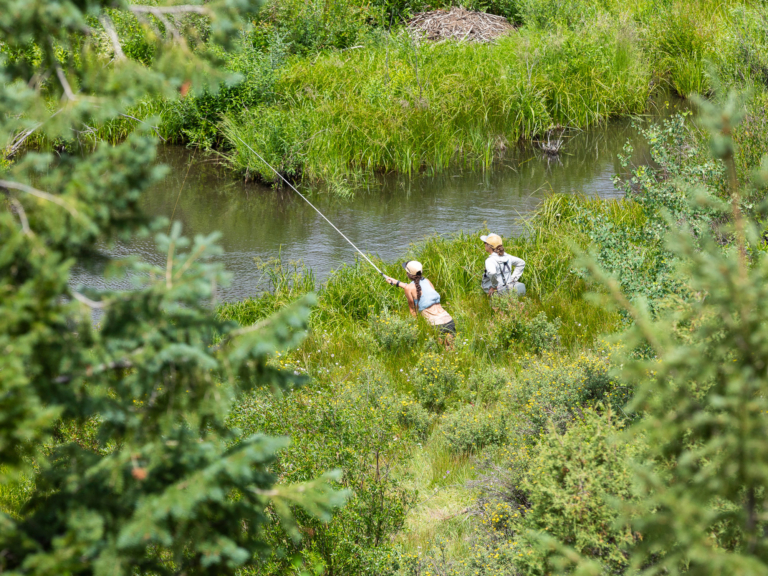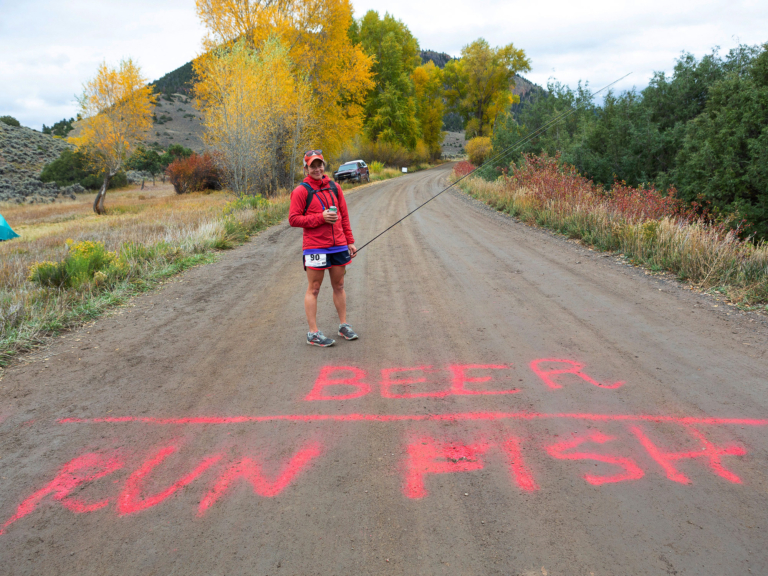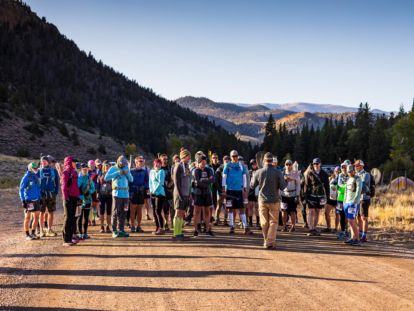Cow Skull Hill
The toughest fish you’ll ever catch could knock a few minutes off your finish time at Flyathlon, a backcountry race in Colorado that combines trail running and fly fishing.
All photos by Craig Hoffman
The plan is to run to Cow Skull Hill as fast as my legs will allow. While other racers duck off trail to catch their fish, I’m tackling the vertical gain leading to the turnaround point perched on a cliff high above the valley.
I pass by men and women frantically assembling fly rods and tying on flies just off trail. They’re scattered along the narrow mountain stream and coming in and out of the brush like bird dogs on a scent. My momentum carries me up into the thin Colorado air as I kick up trail dust, swing my arms and allow myself glances of likely looking fishing holes for the return trip.
“If you go a little farther back, you’ll find the cutthroat,” a race volunteer tells me at the top of Cow Skull, motioning behind him to the trail and into a thick forest of quaking aspen.
Panting as I reach the halfway point, I decline the invitation of a swig of whiskey, a race tradition, quickly stretch my quads and hamstrings and turn around to run in the direction I ran up, my rod and reel still tucked away in my backpack.
Originating in the backcountry of Colorado, Flyathlon is a race that combines trail running and fly fishing. Taking on either the 7-mile short course or 13-mile slog along a small-stream watershed, competitors run then catch a fish, or vice versa, quickly snap a photo and hope their fish’s length is enough to knock a few minutes off their finish time. The larger the fish, the more time off the clock. Catch a native Rio Grande cutthroat and that deduction doubles.
In my first Flyathlon, I prioritize speed over everything—even the catch—and settle for a dumb, non-native brook trout to count as my race fish. I pluck him from a pool just a couple side steps off trail with a dry fly and fumble the photos with shaky hands. Adrenaline greases my engine, and we’re a clumsy, flopping duo of sweat and slime.
He’s not native, but he’s a beauty with deep brown color on his fins and bright yellow spots along his lateral line. I release him after the photo and break down my rod—shoving it and the still-attached reel into my pack. For the remaining 2 miles, I run as fast as my lowland lungs and lactic acid–laced muscles will allow. Back at the trailhead, I’m greeted with a high five and congratulations. I’m the first short-course female to finish.
After I show my fish photo (which shaves 10 minutes off my finish time with my brookie’s 10-inch length), I grab a can from the community cooler, settle into a camp chair, snap the top and drink it all in.

Lightweight, collapsible and effective, tenkara rods are an ideal choice for Flyathlon competitors.
The Flyathlon theme is run, fish, beer. At the original event location near Saguache, Colorado (there are currently four Flyathlon races), the weekend orbits around a forest service outpost that serves as base camp.
Tents, pop-up campers and adventure vans flank the perimeter of a camp containing a fire ring, horseshoe pit and two-keg cooler filled with rotating handles of local brews. There’s conversation and laughter that carry well into the night, sounds of port-a-potty doors slapping shut and, on the night after the race, a communal barbecue dinner and live music courtesy of a rowdy bluegrass trio.
The event is the culmination of Flyathlon founder and water quality specialist Andrew Todd’s experience running in remote areas to fool fish in untouched watersheds. “The farther you get back from the trailhead, the fewer flies those fish have seen,” Andrew explains. “I just didn’t realize how many people might be into the same thing.”
After Andrew divulged his fly fishing/trail running/craft beer obsession to a friend (who confirmed he was also a devotee), the first unofficial Flyathlon was born. Over the years, it’s morphed into an event that gathers competitors from all over the country and has raised more than $400,000 for native trout habitat. Projects funded via Flyathlon events range from headwaters research and fish counts to stream restoration and reclamation, with efforts happening between conservation partnerships (like the Western Native Trout Initiative and Colorado Parks and Wildlife) and even Flyathletes themselves—Andrew often hosts trail and stream work parties. So, when I had heard the Flyathlon was a dirt, trout and conservation party all in one, I wanted in.
“Usually, the disqualifier for a lot of people is running, but beer and fishing typically go hand in hand, as is the case for craft beer drinkers and trail running,” Andrew notes.

Priorities. Kristine Hoffman soaks up the glory at the Flyathlon finish line.
While my first Flyathlon in 2016 saw me in pretty decent shape, returning for my second Flyathlon in 2021 has shifted my physical capabilities since emerging from a post(ish) pandemic world.
In other words, I’m out of shape and would rather have a beer, thank you very much. Flashes pudgy middle finger.
It’s also shifted my mentality. While I mostly pounded pavement in prep for my first Flyathlon, this time, I’m training for the July race on the trails of my local mountain range, the Washington Cascades. The routes for each training excursion vary but offer the same rewards and, most importantly, serenity from the onslaught of my daily surroundings. My path is lined by old-growth trees draped in lime-green moss, punctuated by massive boulders and imposing scree fields. Springtime brings runoff, waterfalls and wildflower season. Fall sends blueberry bushes turning crimson, and the last of summer sunlight squeezes from the Pacific Northwest, concentrating it all in the golden fire of the larch trees. Some trails have rolling sections for running, but most are like jogging up flights of stairs. I capitalize on these moments by taking in the views and watching where my feet land.
I do this training with a much more knowledgeable hiking friend. We end up on alpine lakes with different stocked and native trout species. The lakes vary in emerald, turquoise and filmy glass shades, are surrounded by boulders or shouldered by evergreens, and usually sit in the shadows of a formidable peak.
The window to fish up here is small, and we get out while the last snow is still melting. Some trails have a little less gain, and we run those stretches through the mud, our hamstrings and calves burning on the way up and our quads talking to us on the way down.
It’s only at the top that our muscles can relax, but this is where our brains turn on as we scan the water for rises and entry points on the lakeshore. We watch for insects and thumb through fly boxes, debating between subsurface or topwater, woolly bugger or leach, black or olive.
Most times, our lines are peppered by small, hand-size rainbows—sometimes long, chunky cutthroat—and every time we get asked by passersby on the trail or in our back casts if we’ve had any luck.
Some of the lakes are so clear that we can sight cast to schools cruising the drop-offs. At one point, I turn around to say hello to a couple hiking through, my attention taken for just a few moments. I turn back to the water and see three sizeable westslope cutthroat circled around my streamer.
Rolling up to the camp for this year’s Flyathlon feels like a different lifetime from the last. Andrew and a few board members of Running Rivers, the nonprofit established to oversee Flyathlon, set up for the weekend. Aside from that, the place is empty, but with the sounds of tent poles going into the ground and trailers backing up, it resonates an energy of excitement in anticipation for the swelling presence of an in-person gathering.
My goal for this year’s race is to catch a native Rio Grande cutthroat. That evening, I feel better about prioritizing the catch over quickness when I see small groups of people on shakeout runs. Even the laidback nature of the event seems to have shifted as I notice a more athletic presence around the bonfire and keg.
While these people are duking it out on the trail, I’ll be in the farthest reaches of the woods catching my first native Colorado trout. That’s the plan, but it may prove difficult as Andrew confirms the fishing is not the easiest this year. Exceptionally dry years in 2018 and 2020 may have likely strained the otherwise plentiful native trout fishery. Water volume carries a more significant impact on a tiny headwater stream. Too much water—as might have been the case for 2019—and you can flush out fish. Too little water and habitat dries up.
We’re also using sewing ruler tape instead of our bibs to measure fish, keeping the fish submerged in our nets. We go over these and a couple other housekeeping items while circled up in the yard for the race debrief as off-leash dogs and free-range children roam.

Flyathlon competitors head to where the wild trout (hopefully) are.
The next morning at the trailhead, the sky is an uncharacteristically bright blue compared to the onslaught of recent thunderstorms. The race route is the same as before—the trail begins at the edge of a marshy valley and travels up into a stand of pine trees to Cow Skull. We stretch and sway in anticipation, our fly rod pieces and nets secured in our running packs, and Andrew gives us one last rundown. He pulls out a BB gun, aims it at a tall boy of crappy suds on the ground and pops a hole in it with a metallic chink, sending a foamy spray into the air, signaling the start of the race.
The group splits—the long-course runners heading right while we short-coursers keep left along the valley. I hang toward the back as others quickly pull away. For the first few moments, it’s just my cadenced breath and the wind in the pines.
The farther I climb, the more arid my surroundings. On my ascent, a few runners have already bolted past me on their way back down, flashing friendly and—to my surprise—fresh smiles. One woman looks like she eats these hills as part of a balanced breakfast.
I reach the top and take a minute to suck wind before accepting the traditional mid-point shot of whisky. With a light breeze swirling around us at the exposed ledge (and a hanging Colorado flag flapping on the cow fence), I assemble my fly rod, gauging the volunteers on how many people might be back there going after cutthroat.
“About a dozen.”
Bad news.
“But no one’s having any luck.”
Well, that’s nice.
From yesterday’s scouting trek, I learned that dense foliage limits access points. I head down into the trees, jogging past a few anglers in their running gear hidden by aspen, alder and maple casting to small boulder spills and tiny creek pools. There’s a spot at the bottom of an embankment not visible from the trail that I’m hoping is unoccupied.
It is. I scramble over deadfall to a sand bar just wide enough for my running shoes (that is, if you count roll casting, because even my three-weight is a bit much for this tight spot).
Immediately I get a strike, but I’m pretty sure it’s a minnow because it’s pushed my fly off the water. This happens a few more times before even the small fry go quiet, and I’m left with the sound of the creek and a sore shoulder from holding out my arm.
I switch flies. I alter where I drop them and how I drift them. I try nymphs, and I try waiting, but the race clock is ticking. There’s the swishing of dead leaves, and a man appears to my right. He asks if I’d had any luck, and I say, “a little” before he leaves me to my mission.
The sun dips in and out of threatening rain clouds, and I can sense people leaving the forest. I stop checking my watch after 40 minutes. I don’t care what my time is—all that matters is this fish.
But as it seems to go with waiting and fly fishing, my resolve deepens and something changes, like a barometric drop, a change in temperature, a moving tide and then … snaps chubby finger.
The strike is small, like a popcorn kernel.
I jerk and breathe loud and awkwardly, “Ahh!” setting the hook with too much surprise for a small fish that I pull it entirely out of the water. In one adrenaline-filled motion, I gently pull him through the water while leaning down to fumble for the net, chanting, “Don’t come off, don’t come off …” and plop him securely into the submerged rubber netting.
I emerge from the quaking aspen at Cow Skull Hill—the volunteers already in the process of taking down camp—and hoist the three-weight victoriously above my head for the five-inch cutthroat.
There are still a few miles to cover, but I’ve got the momentum to carry me downhill.

